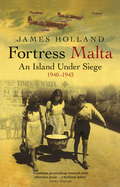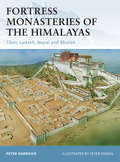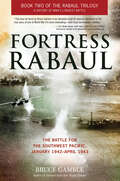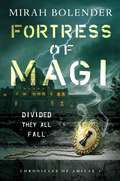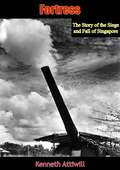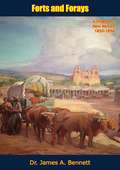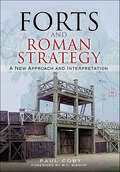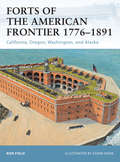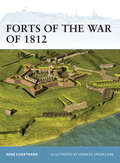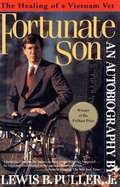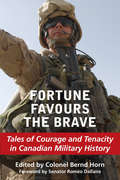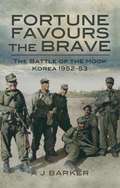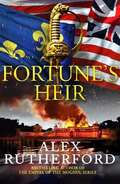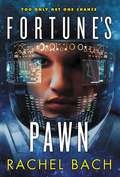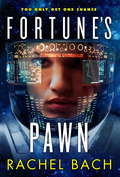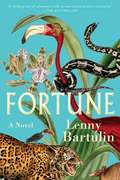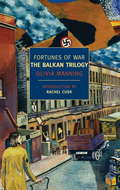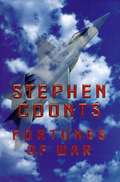- Table View
- List View
Fortress Kent
by Roy IngletonSince the dawn of civilization, Britain has been menaced by foreign powers and invasive hordes, anxious either to pillage and plunder or to invade and rule over this green and pleasant land. Situated on the extreme southeastern corner of England, the county of Kent is the nearest point to continental Europe, and has so been the targeted landing point for most of these incursions. From the time of the Angles, Jutes and Saxons to the Second World War, the Men of Kent and Kentish Men have had to set up and maintain defensive structures, from Norman castles to 1940 pill boxes, from the Royal Military Canal to the anti-tank ditches carved out of the hills around the coast. This book is the story of these: the threats which led to the erection and construction of various defensive obstacles, their upkeep and garrisoning and, in some cases, their ultimate destruction.
Fortress Malta: An Island Under Siege 1940-1943
by James HollandThe extraordinary drama of Malta's WWII victory against impossible odds told through the eyes of the people who were there.In March and April 1942, more explosives were dropped on the tiny Mediterranean island of Malta - smaller than the Isle of Wight - than on the whole of Britain during the first year of the Blitz. Malta had become one of the most strategically important places in the world. From there, the Allies could attack Axis supply lines to North Africa; without it, Rommel would be able to march unchecked into Egypt, Suez and the Middle East. For the Allies this would have been catastrophic. As Churchill said, Malta had to be held 'at all costs'.FORTRESS MALTA follows the story through the eyes of those who were there: young men such as twenty-year-old fighter pilot Raoul Daddo-Langlois, anti-aircraft gunner Ken Griffiths, American Art Roscoe and submariner Tubby Crawford - who served on the most successful Allied submarine of the Second World War; cabaret dancer-turned RAF plotter Christina Ratcliffe, and her lover, the brilliant and irrepressible reconnaissance pilot, Adrian Warburton. Their stories and others provide extraordinary first-hand accounts of heroism, resilience, love, and loss, highlighting one of the most remarkable stories of World War II.
Fortress Malta: An Island Under Siege 1940-1943 (W&N Military)
by James HollandThe extraordinary drama of Malta's WWII victory against impossible odds told through the eyes of the people who were there.In March and April 1942, more explosives were dropped on the tiny Mediterranean island of Malta - smaller than the Isle of Wight - than on the whole of Britain during the first year of the Blitz. Malta had become one of the most strategically important places in the world. From there, the Allies could attack Axis supply lines to North Africa; without it, Rommel would be able to march unchecked into Egypt, Suez and the Middle East. For the Allies this would have been catastrophic. As Churchill said, Malta had to be held 'at all costs'.FORTRESS MALTA follows the story through the eyes of those who were there: young men such as twenty-year-old fighter pilot Raoul Daddo-Langlois, anti-aircraft gunner Ken Griffiths, American Art Roscoe and submariner Tubby Crawford - who served on the most successful Allied submarine of the Second World War; cabaret dancer-turned RAF plotter Christina Ratcliffe, and her lover, the brilliant and irrepressible reconnaissance pilot, Adrian Warburton. Their stories and others provide extraordinary first-hand accounts of heroism, resilience, love, and loss, highlighting one of the most remarkable stories of World War II.
Fortress Monasteries of the Himalayas
by Peter Dennis Peter HarrisonBuddhism has been influential in the mountain kingdoms of the Himalayas since the 7th century AD, most notably in the kingdom of Tibet where it permeated all aspects and levels of society until the 20th century. From the 9th-century AD onwards, the secular rulers of Tibet sought to extend their influence, and that of Buddhism, throughout the region. To this end, huge stone and mud-brick fortifications, known as dzongs, were constructed to dominate the secular landscape, while massive Buddhist monasteries dominated the religious - both following a very specific style of Tibetan architecture. It has been estimated that as many as 3,000 monasteries were built along with 200 dzongs. Mongol invasions from the 12th century onwards provided another influence, while internecine fighting in the 17th century led to increased fortification of the monasteries and the rise of the Dalai Lama as the head of a theocracy in Tibet, centred on the Potala Palace in Lhasa - a true fusion between secular dzong and religious monastery.Elsewhere in the Tibetan-influenced Himlayas the Buddhist Indian Kashmiri kingdom of Ladakh withstood assaults by both Muslims and Sikhs and developed a style of fortress monastery located on rocky peaks for defence, these often became combined with the fortified palaces of the rulers of Ladakh. With the foundation of Bhutan in the 17th century, further fortified monasteries were created in an effort to protect the new state's independence form the Dalai Lama.These fortifications have survived largely intact through today, as Chinese control over the Tibetan Autonomous Region has led to the destruction of the vast majority of the fortified monasteries and dzongs of that particular area.This title recreates the dramatic and colorful fortifications created in these mountain kingdoms, and recounts their operational history through the foreign incursions, religious conflicts and civil wars that litter their history, right through to the Tibetan uprising and flight of the Dalai Lama form the Potala Palace in 1959
Fortress Rabaul: The Battle for the Southwest Pacific, January 1942–April 1943 (The Rabaul Trilogy)
by Bruce Gamble“This tour de force . . . is an absolute must for anyone interested in the true story of one of World War II’s most interesting—and most overlooked—battles.” —Col. Walter Boyne, USAF (Ret.), author of Clash of WingsFor most of World War II, the mention of Japan’s island stronghold sent shudders through thousands of Allied airmen. Some called it “Fortress Rabaul,” an apt name for the headquarters of the Imperial Japanese forces in the Southwest Pacific. Author Bruce Gamble chronicles Rabaul’s crucial role in Japanese operations in the Southwest Pacific. Millions of square feet of housing and storage facilities supported a hundred thousand soldiers and naval personnel. Simpson Harbor and the airfields were the focus of hundreds of missions by American air forces.Winner of the “Gold Medal” (Military Writers Society of America) and “Editor’s Choice Award” (Stone and Stone Second World War Books), Fortress Rabaul details a critical and, until now, little understood chapter in the history of World War II.“Not for the first time, Bruce Gamble has done amazing work gathering a dazzling array of tiny, little facts, then arranging them in a big, dazzling story that amazes one’s inner historian even as it breaks one’s heart on its way to a triumphal conclusion.” —Eric Hammel, author of Two Flags over Iwo Jima“Drawing on a variety of sources from both sides, the author has written a detailed reference book that reads like a novel.” —Air Classics“Fortress Rabaul opens a broader vista on this under-studied campaign with its wide research, thoughtful analysis, and gifted story-teller’s panache.” —WWII History Magazine
Fortress in Orion (Dead Enders #1)
by Mike ResnickThe Democracy is at war with the alien Traanskei Coalition. War hero Colonel Nathan Pretorius has a record of success on dangerous behind-enemy-lines missions, missions that usually leave him in the hospital. Now he's recruited for a near-impossible assignment that may well leave him dead. At the cost of many lives, the Democracy has managed to clone and train General Michkag, one of the Traanskei's master strategists. Colonel Pretorius and a hand-picked team must kidnap the real Michkag if they can, assassinate him if they can't, but no matter which, put the clone in his place, where he will misdirect the enemy's forces and funnel vital information to the Democracy. Against the odds, Pretorius, along with Cyborg Felix Ortega, computer expert Toni Levi, convict and contortionist Sally "Snake" Kowalski, the near-human empath Marlowe, the alien Gzychurlyx, and Madam Methuselah - the Dead Enders - must infiltrate the Fortress in Orion, accomplish their mission, and escape with their lives.
Fortress of Magi (Chronicles of Amicae #3)
by Mirah BolenderMirah Bolender follows The Monstrous Citadel with Fortress of Magi—the pulse-pounding conclusion to her debut fantasy trilogy in which a bomb squad defuses the magic weapons of a long forgotten warThe Hive Mind has done the impossible—left its island prison. It's a matter of time before Amicae falls, and Laura Kramer has very few resources left to prevent it.The council has tied her hands, and the gangs want her dead. Her only real choice is to walk away and leave the city to its fate.Chronicles of AmicaeCity of Broken MagicThe Monstrous CitadelFortress of MagiAt the Publisher's request, this title is being sold without Digital Rights Management Software (DRM) applied.
Fortress: The Story of the Siege and Fall of Singapore
by Kenneth AttiwillFortress: The Story of the Siege and Fall of Singapore, first published in 1959, is the sobering account of the failed defense of Singapore in late 1941 and early 1942 against the advancing Japanese Army.In Fortress, author Kenneth Attiwill—himself a prisoner of the Japanese for three and a half years—recreates, in vivid detail, the fall of Singapore in World War II: the unforgettable atmosphere of chaos, misunderstanding, panic bombings, evacuation of civilians, ill-trained troops, the invasion of Japanese troops, and the beginnings of tortures as the “Fortress” fell.Here is an engrossing analysis of the Singapore defeat—in strategy caused by the failure of the Chief of Staff in London to activate the British defense in Malaya; in the air due to disorganization at Air Command Headquarters; on the sea, because Japanese efficiency was underestimated; and on land, through misjudgment of the invasion of Malaya.Richly illustrated throughout with 14 pages of maps and photographs.
Fortresses of the Peninsular War 1808-14
by Chris Taylor Ian FletcherIn the course of the Peninsular War, Wellington's army fought several hard battles and smaller actions, but it was the bloody sieges that troubled him more than anything else. Indeed, the performance of his army during the sieges was probably the most disappointing aspect of what was otherwise an extremely successful campaign. Taking 1808 as its starting point, this title deals with the fortress sieges that involved Wellington's AngloPortuguese army, and concentrates on four key sites in particular (Ciudad Rodrigo, Badajoz, Burgos and San Sebastián). All of these played a vital role in the war due to their strategically important positions. It documents both the sieges and the storming of the fortresses, as well as the general role of the fortresses in Spain and the impact they had on the thinking of the commanders and strategies of the armies involved.
Forts and Forays: A Dragoon in New Mexico, 1850-1856
by Dr James A. Bennett Clinton E. BrooksForts and Forays is a rare account of frontier soldiering in the pre-Civil War Southwest by an enlisted man. James A. Bennett joined the regular army in 1849 and was stationed in New Mexico for six years before he deserted to Mexico. Assigned to the First Dragoons, he visited most major New Mexico posts such as Forts Union, Craig, and Fillmore. His company was stationed at or passed through Taos, Santa Fe, Albuquerque, Socorro, and other New Mexico settlements. In six years, his rank climbed from private to sergeant before an unknown infraction reduced him to the ranks. Bennett served under future Civil War generals Edwin V. Sumner, Richard S. Ewell, and John W. Davidson.During his service, Bennett waged war on the Kicarilla, Mogollon, Mescalero, and Mimbres Apaches, the Navajos, and the Utes, suffering serious wounds at the Battle of Cienguilla Forts and Forays is a unique glimpse into the routine duties and terrifying ordeals of soldiering in the antebellum Southwest.
Forts and Roman Strategy: A New Approach and Interpretation
by Paul CobyPaul Coby here proposes a new system for the recording and mapping of Roman forts and fortifications that integrates all the data, including size, dating and identification of occupying units. Application of these methods allows analysis that brings new insights into the placement of these forts, the units garrisoning them and the strategy of conquest and defense they underpinned. This is a new and original contribution to the long-running debate over whether the Roman Empire had a coherent grand strategy or merely reacted piecemeal to emerging needs. Although the author focuses on several major campaigns in Britain as case studies, the author stresses that his method's are also applicable to elsewhere in the Empire. Lavishly illustrated with color maps, the book is also supported by a website and blogs, encouraging further investigation and discussion.
Forts of the American Frontier 1776-1891
by Adam Hook Ron FieldWith the violent separation between the United States and Britain which began in 1776, the new 'Americans' set off to fulfill their manifest destiny and rule their new land from coast to coast. As they pushed westward, they came into conflict with both natives and other European settlers, and began to build fortresses to defend their newly claimed land. This book charts the development and variation of the fortresses of the American Frontier, covering both American defenses and those of the Spanish in the west. It also examines the little-known forts of early Russian settlers on the Pacific coast.
Forts of the War of 1812
by René Chartrand Donato SpedaliereWhen war broke out between the United States and Great Britain in 1812, neither side was prepared for the conflict, as evidenced by their respective fortifications. The most sophisticated and modern fortifications were those built by the US Corps of Engineers to protect some of the main port cities. These included Fort Mifflin in Philadelphia, Fort McHenry in Baltimore and Castle William in New York. The British also heavily fortified their main harbor at Halifax and their main center of power at Quebec. However, elsewhere, especially in the interior, fortifications were old, neglected or only hastily erected. The forts at Detroit and Mackinac were much as the British had left them in 1796. This book covers all of the main fortifications of the conflict, those that faced the crashing of guns and those whose intimidation played a part in the grand strategy of the war.
Fortunate Son: The Autobiography of Lewis B. Puller, Jr.
by Lewis B. PullerLewis B. Puller, Jr., the son of the most decorated Marine in the Corps' history, volunteered for duty in Vietnam after college. He came home a few months later missing both legs, his left hand, and two fingers of his right hand. He would never walk again, though he would complete law school, serve on President Ford's clemency board, and run for Congress. He would also live with the nightmares of Vietnam, and his growing dependence on alcohol. Few have told their story with more honesty, or more devastating openness.<P><P> Pulitzer Prize Winner
Fortune Favours the Brave: Tales of Courage and Tenacity in Canadian Military History
by Colonel Bernd Horn Senator Romeo DallaireMany Canadians see the role their country’s military plays in Afghanistan as an anomaly. However, this assumption is far from the truth. As U.S. Secretary of State Condoleezza Rice has commented, "Canadians are fierce fighters." Fortune Favours the Brave certainly proves this point in a collection of essays that showcases the fighting spirit and courage of Canada’s military. Daring actions featured in the book include the intrepid assault on the Fortress of Louisbourg and the cat-and-mouse struggle between Canadian partisans and Rogers’s Rangers in the Seven Years’ War in the 1750s; the seesaw battle for the Niagara frontier in the War of 1812; an innovative trench raid in the First World War; the valiant parachute assault to penetrate the Third Reich in the Second World War; the infamous battle at Kap’yong in the Korean War; covert submarine operations during the Cold War; the Medak Pocket clash in Croatia in the early 1990s; and Operation Medusa in Afghanistan.
Fortune Favours the Brave: The Battles of the Hook Korea, 1952–53 (Military History Ser.)
by A.J. BarkerAll too little remembered today, the Korean War was bitterly fought out under atrocious conditions of weather and terrain. Greatly outnumbered by their Communist Chinese and North Korean enemy, the United Nations forces fought with extraordinary resolve and gallantry. The Hook, the name given to a prominent ridge on the Peninsula, saw more blood spilt than any other feature in this prolonged and grisly war. Not surprisingly it became known as 'the bloody Hood'.The two costliest battles are described in detail in Fortune Favours The Brave, a classic account of the war. Both involved British infantry battalions of 29 Commonwealth Brigade. In November 1952, The Black Watch saw off a major Chinese attack against all odds. In May 1953 it was the turn of 1st Battalion, The Duke of Wellington's Regiment to face what must have seemed an overwhelming onslaught. Along a 1,000 yard front the greatest concentration of artillery fire since the Great War was brought to bear on Chinese human-wave attacks.In the morning the Dukes still held the ground despite heavy casualties. This feat of arms, achieved by battalion made up mainly of young National Servicemen from yorkshire, ranks among the finest in the long and glorious history of the British Army.
Fortune's Heir: The Ballantyne Chronicles Book #2
by Alex RutherfordThe long-anticipated sequel to Fortune's Soldier, from the author of the Empire of the Moghul series. In his Himalayan retreat of Glenmire, Nicholas Ballantyne is determined his days of bloodshed and intrigue in the service of the British East India Company are over. Yet the Battle of Plassey, where he fought with Robert Clive, has delivered only a short-lived peace and the 1770s are precarious times in India. Martial Marathas, formidable Sikhs and wild Afghan Rohillas threaten not only each other, but the Company’s very existence. Most dangerous of all are the militarily astute Hyder Ali and his charismatic son Tipu Sultan, the Tiger of Mysore, who – with strong French support – are intent on driving the British into the sea. When Warren Hastings, the Company’s newly appointed Governor-General, beset by internal rivalries, seeks Nicholas’ help, he agrees. Though long-cynical about the Company, he foresees a bloodbath that could rip India apart, cause thousands of deaths and imperil his own family. A quiet life must wait.
Fortune's Light (Star Trek: The Next Generation #15)
by Michael Jan FriedmanDante Maxima Seven -- a world known to its inhabitants as Imprima. A world where Madragi -- huge social/economic entities wealthy beyond compare -- control the fate of millions.. Years ago, William Riker was part of the Starfleet delegation that opened Imprima to the Federation. Now the disappearance of an old friend -- Teller Conlon, who also served on that team -- draws Riker and the Enterprise across the galaxy, back to Imprima. Because the jewel known as Fortune's Light -- one of Madraga Criathis's most priceless possessions -- has been stolen. And Teller Conlon stands accused of its theft. Now Riker must discover the truth behind the disappearance of both his friend and Fortune's Light, no easy task on a world where treachery and intrigue are commonplace...and where even an old friend's embrace may conceal the deadly bite of a dagger's blade.
Fortune's Pawn (Paradox #1)
by Rachel BachDevi Morris isn't your average mercenary. She has plans. Big ones. And a ton of ambition. It's a combination that's going to get her killed one day - but not just yet. That is, until she just gets a job on a tiny trade ship with a nasty reputation for surprises. The Glorious Fool isn't misnamed: it likes to get into trouble, so much so that one year of security work under its captain is equal to five years everywhere else. With odds like that, Devi knows she's found the perfect way to get the jump on the next part of her Plan. But the Fool doesn't give up its secrets without a fight, and one year on this ship might be more than even Devi can handle. If Sigouney Weaver in Alien met Starbuck in Battlestar Galactica, you'd get Deviana Morris -- a hot new mercenary earning her stripes to join an elite fighting force. Until one alien bite throws her whole future into jeopardy.ing to have to get some answers fast, before all the secrets send her home in a body bag.
Fortune's Pawn: Book 1 of Paradox (Paradox #1)
by Rachel BachFans of Firefly and Elizabeth Moon will lap up this action-packed military science fiction series. Welcome to the start of a thrilling new space adventure, starring female mercenary Deviana Morris . . .Deviana Morris isn't your average mercenary. She has plans. Big ones. And a ton of ambition. One of those is going to get her killed one day - but not just yet. Not when she just got a job on a tiny trade ship with a nasty reputation for surprises. The Glorious Fool isn't misnamed: it likes to get into trouble. And with a reputation for bad luck that makes one year as security detail on this ship equal to five years everywhere else - Devi knows she's found the perfect way to get the jump on the next part of her Plan. But the Fool doesn't give up its secrets without a fight, and one year might be more than even Devi can handle.Review for FORTUNE'S PAWN:'This book kicked ass . . . I just loved it!' - FELICIA DAY'Devi is hands-down one of the best sci-fi heroines I've read in years' - RT BOOK REVIEWS'Rollicking space opera starring a tough, sexy, armor-clad space chick . . . [Bach] does a nice job of painting a scenario that, if familiar - think the space marines of the Alien franchise or the motley crew of Firefly - allows her plenty of room for action. And action aplenty is what she delivers . . . Lots of fun' - KIRKUS REVIEWS
Fortune's Second-Chance Cowboy (The Fortunes of Texas: The Secret Fortunes)
by Marie FerrarellaWELCOME HOME, CHLOE FORTUNE! "You're family," Graham Fortune tells his newly discovered half sister, Chloe Fortune Elliott, and just like that, Chloe has a new job and a new home in Austin. She works well with the troubled teens at Peter's Place, but she's having more difficulty managing a male of the grown-up variety. Ranch hand Chance Howell gets under her skin from the moment they meet. The tall blond army veteran is good with horses and adolescents, but he's a master at avoiding intimacy. Maybe that's why Chloe is so drawn to him. Or maybe it's the sadness she recognizes in his eyes. Her head tells her falling for Chance is a bad idea. Her heart tells her she may have no choice...
Fortune: A Novel
by Lenny BartulinAn audacious, entertaining historical epic spanning continents and centuries, for readers of David Mitchell, Column McCann, Kate Atkinson, and Eleanor Catton.Fortune is a dazzling, endlessly surprising, and gripping historical novel that opens the day Napoleon leads his victorious Grande Armée into Berlin after having conquered Prussia in battle. As crowds throng the streets to witness this momentous event, a handful of lives that briefly touch are sprung from their orbits and set on courses that will take them across Europe and around the world—their fates and desires sometimes intersecting—to strange lands in the Caribbean and South America, the Australian continent and van Diemen's Land, and back to a Europe now transformed.A frustrated general in Napoleon's army, billeted with one of Berlin's finest families. Elisabeth, a passionate young woman living with her aunt in that house. A young man of eighteen years and no particular talent, drawn to the smoky coffeehouses where students debate, whom she spies through a window fornicating with a serving girl at the moment Napoleon makes his grand entrance. An entrepreneur in New World exotica with a passion for shrunken heads, to whose house the young man was led for his tryst. A slave from Suriname, Mr. Hendriks, with his resentful white American companion, who have traveled to Berlin to sell a barrel of electric eels for their master. And a student enamored of philosophy, who will join Mr. Hendricks and the American on their return voyage. Through their stories amid war, cataclysm, colliding cultures, and misadventure, Lenny Bartulin imagines the ways that grand events in extraordinary times can shape the course of ordinary lives.
Fortunes of War
by Olivia Manning Rachel CuskThe Balkan Trilogy is the story of a marriage and of a war, a vast, teeming, and complex masterpiece in which Olivia Manning brings the uncertainty and adventure of civilian existence under political and military siege to vibrant life. Manning's focus is not the battlefield but the café and kitchen, the bedroom and street, the fabric of the everyday world that has been irrevocably changed by war, yet remains unchanged.At the heart of the trilogy are newlyweds Guy and Harriet Pringle, who arrive in Bucharest--the so-called Paris of the East--in the fall of 1939, just weeks after the German invasion of Poland. Guy, an Englishman teaching at the university, is as wantonly gregarious as his wife is introverted, and Harriet is shocked to discover that she must share her adored husband with a wide circle of friends and acquaintances. Other surprises follow: Romania joins the Axis, and before long German soldiers overrun the capital. The Pringles flee south to Greece, part of a group of refugees made up of White Russians, journalists, con artists, and dignitaries. In Athens, however, the couple will face a new challenge of their own, as great in its way as the still-expanding theater of war.
Fortunes of War
by Stephen CoontsIt is the near future. Russia is disintegrating; Japan is in economic decline. Some of japann's leaders execute a bold plan to make Japan great again -- the invasion of siberia. As American and Japanese planes once again battle each other in the skies, the world moves closer and closer to the brink! As in all wars, it is the personal courage and honor of individuals, not the grand strategies of politicians, which will decide the fate of nations -- and of the world.
Fortunes of War
by Stephen CoontsFour Japanese nationalists storm Tokyo's imperial palace and behead the emperor. Their goal: to invade Russia and conquer oil-rich Siberia in order to dominate the globe. Soon the world explodes in war, as Japan, Russia and the United States go head-to-head in a struggle that threatens total destruction. Now three men from three different nations must meet their ultimate challenge: to fight as patriots in a war driven by greed and madness--and save the planet from nothing less than a full-scale nuclear attack.Stephen Coonts' Fortunes of War is an explosive, action-packed thriller.

